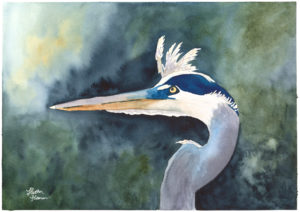Great Blue Heron
Raise your hand if you’ve ever witnessed one of Florida’s most majestic avian residents-the Great Blue Heron. They truly are a sight to behold standing at 4 and a half feet tall, with wings that stretch to 6 feet, and a dark blueish black stripe around the eyes. These features along with their blue-gray appearance distinguish this heron from their other feathered friends.
The Great Blue Heron is the largest of North American herons and finds its home from northern Alaska to South America, depending on the time of year. They build their nests in trees or bushes near water and rest in shady spots all curled up with a good book. Just kidding, but if they were to read a book it would probably be titled “The Herons Guide to Living Solo”. After being together in the nesting colonies from March to May or November to April (depending on the range where they live) herons live in solitude during the off-season. This characteristic is the opposite of many other species. They breed once a year in these nesting colonies. Mom and dad both incubate the eggs for about 4 weeks and baby herons take their first flight around 60 days old. Other traits that set this heron apart include hovering over the water before dropping their feet to pick up prey and swimming in deep waters.
The menu for Great Blue Herons is mainly fish but on special occasions, they’ll snack on amphibians, small mammals and reptiles, insects, crustaceans, and worms. The common places you’ll find a heron hanging out are near saltwater and freshwater habitats. Whether it’s marshes, riverbanks, lakes, or koi ponds-herons want to be where the fishies are found. They search for food stealthily and silently along the shoreline to stab the prey with their powerful bill. The main predators these herons will encounter are mainly animals that hunt for eggs during the incubation period. However, they are known to sleep in trees at night to avoid land-dwelling predators. When they’re successful at evading predators, Great Blue Herons will live up to 15 years.
Interested in seeing a Great Blue Heron in real life? Below you’ll find a few beautiful Florida nature trails you can visit.
Lake Apopka Wildlife Drive-This trail is a local favorite! Enjoy birds, reptiles, and more from the comfort of your car.
Oakland Nature Preserve-Explore this 128-acre preserve that offers ecotourism activities for all ages. The best part? It’s open year-round at no charge.
Lake Louisa State Park-Hike or paddle your way through this Florida State Park on your search for the Great Blue Heron.




